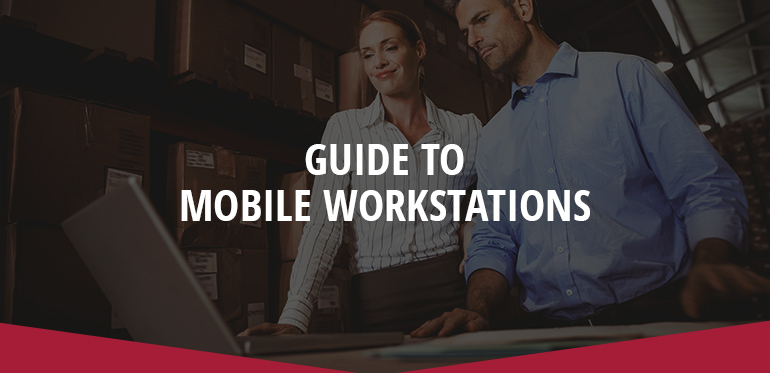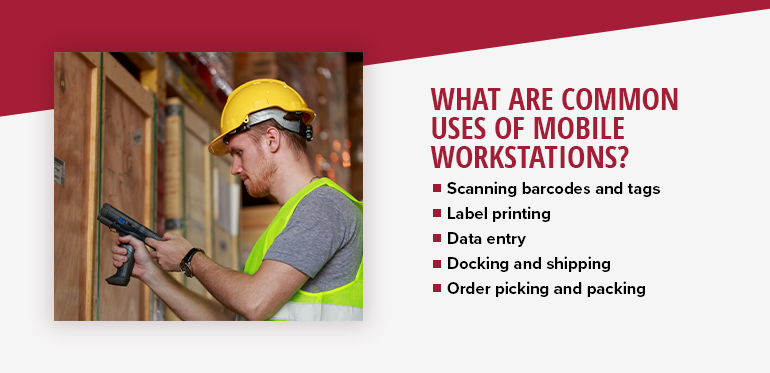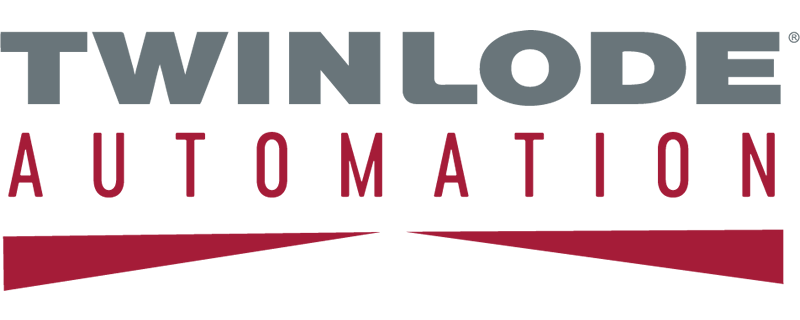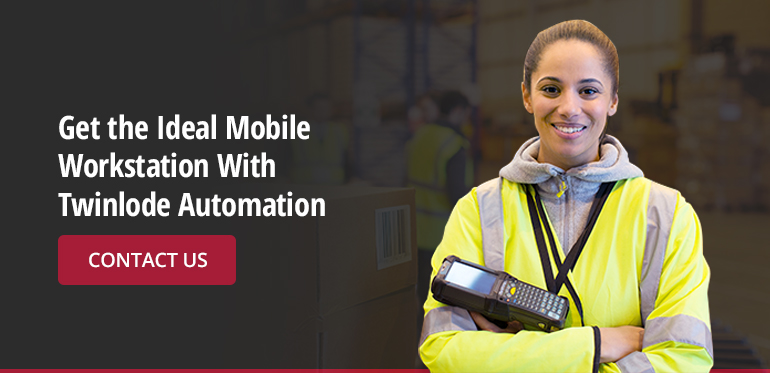
30 May Guide to Mobile Workstations
In large workplaces, traveling long distances to reach a computer is hardly efficient, yet that is what many employees do. Permanent workstations might have printers, label printers, scanners, and other resources, but they are also tied down with cables and stationary desks. A mobile workstation puts all of those resources on wheels and powers them with a long-lasting battery that keeps employees productive throughout the day.
Mobile computer workstations are powerful tools for large work environments, such as warehouses, distribution centers, and factories. They can help warehouse workers boost efficiency while eliminating motion waste from walking back and forth from work area to work station.
Contact Us
What Are Mobile Workstations?
A mobile workstation puts stationary electronics, such as computers and printers, on a wheeled, battery-powered platform. Employees can take these electronics to nearly any location in the facility, such as on a loading dock or near pallet racking, instead of trekking across the warehouse to get to them. Portable computer carts can accommodate many types of equipment and business environments.
Mobile computer workstations typically offer:
- Large batteries: These flexible workstations incorporate powerful batteries that can last through multiple shifts to support the same equipment that normally requires a wall outlet, such as scanners, printers, and computers. Some even offer spare batteries that employees can quickly swap out to extend power availability.
- Equipment-specific configurations: Workstations can often be configured to have brackets, mounts, and sliding shelves that hold equipment, such as keyboards, barcode scanners, label printers, and monitors.
- Adjustable heights: A workstation can adjust its height to suit different workers and tasks. Whether a worker sits down to put labels on shipments or walks around as they scan orders, mobile warehouse workstations can simplify the process.
While mobile workstations can come in many styles, some models are more rugged than others. For example, one designed for a warehouse or industrial facility could use a sturdy, easy-to-clean metal construction.

What Are Common Uses of Mobile Workstations?
Mobile computer carts are commonly used in large facilities, such as factories and warehouses, where employees must walk long distances. Workstations can minimize traveling and increase productivity by allowing workers to bring their tools. It offers consistent access to supplies and computer systems and the flexibility to perform various tasks.
Some of the tasks employees can use portable workstations for include:
- Scanning barcodes and tags: Many warehouses run on scanning, and a workstation can keep the necessary tools close at hand. Mobile workstations support scanners themselves, as well as printers and computers to record data. Workstations pair well with barcode and radio frequency identification (RFID) tags for accurate inventory management, shipping and receiving, and other supply chain activities.
- Label printing: Running back and forth to pick up labels and tags is time-consuming and inefficient. Mobile workstations allow workers to access a computer or tablet for printing, and they get the label from the same location.
- Data entry: Without a computer, workers might turn to writing down or trying to memorize information as they move from data collection to data entry. A mobile workstation allows them to enter data from the point of collection. For example, an employee could update inventory counts directly into a computer, eliminating a step and reducing the potential for errors. Other immediate data-entry tasks might include collecting signatures and confirming delivery or shipment details.
- Docking and shipping: Warehouses may be unable to keep permanent workstations at loading docks and bays, but employees can wheel workstations in and out as needed. They can print out materials, such as bills of lading and inventory adjustments, in a convenient, time-saving location.
- Order picking and packing: At a workstation, employees have more space to set down and transport items and work with packaging materials. They can move orders to different locations with more stability thanks to the workstation. Workstations also give employees access to digitized picking lists they can bring to the point of task.
Benefits of Mobile Workstations
While productivity is one of the primary benefits of mobile warehouse workstations, they can also help in areas such as employee ergonomics and workplace flexibility.
1. Efficiency and Productivity
By eliminating travel time and enabling immediate data entry and access, these workstations can allow employees to work faster and stay organized. Critical resources are compiled together in one place, so they can keep tools at arm’s reach. They also keep tools organized, so management can easily track assets and employees can quickly find what they need.
2. Flexibility
A mobile workstation provides more flexibility for employees to move around freely and quickly access the tools they need. They aren’t tied down to a specific part of the facility, such as a desk with a computer. Workers can bring all of their resources to the most efficient location and get the job done more effectively.
3. Employee Ergonomics
Musculoskeletal disorders (MSDs) are one of the most common reasons for lost or restricted work time and often come from ergonomic issues, such as bending, working in awkward positions, or performing repetitive tasks. Mobile workstations offer a better ergonomic environment by helping employees avoid this kind of bodily strain. These stations are designed to promote good posture and keep workers in a comfortable, standing position.
Workstations can also promote healthy workplaces by reducing tripping hazards from cords, collisions from heavy foot traffic, and overexertion due to excessive walking.
Essential Elements of a Mobile Workstation
Some important components in a mobile workstation include:
- Extra and high-quality batteries: Keeping an extra battery or a charger on hand can help workers avoid running out of power for their devices during the work day. Look for lithium iron phosphate (LFP) batteries. They typically offer much longer life spans and lower costs than nickel manganese cobalt (NMC) batteries, which are the other kind of battery commonly used in mobile workstations. LFP batteries also provide safer and cleaner energy along with fast charging power.
- Mounting equipment: Brackets and mounts allow workers to grab equipment quickly and store it safely. A mobile workstation might have brackets for scanners or label printers to keep them secure when not in use.
- Printers: Employees can print labels and documents right from the workstation for immediate use, streamlining shipping and receiving processes.
- Storage: Drawers and shelves offer places to keep documents and other items securely in the workstation to avoid misplacement.
How to Know if Mobile Workstations Are Right for Your Business
When deciding whether to implement mobile workstations, consider how the typical workflow looks and whether employees spend considerable time walking to and from permanent workstations. Spend some time understanding their biggest challenges and asking questions about travel time, physical health, and equipment use. Discuss communication methods and whether errors occur due to messages and data not being updated right away.
A mobile workstation could offer significant benefits if workers have problems in any of these areas. A customizable workstation can be configured to the unique needs of any workflow for a high return on investment.
Get the Ideal Mobile Workstation With Twinlode Automation
The simple addition of a mobile workstation makes a significant difference in productivity and workflow for many businesses. For the best results, it is important to use portable computer carts built for the company’s needs. Through our partnership with DTG, we offer fully configurable, durable workstations that help employees work more efficiently and stay safe. The MPOWER battery system provides long-lasting, instant-swap batteries that recharge in just two hours for virtually no downtime.




